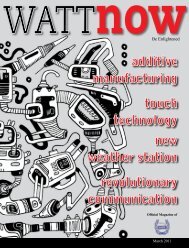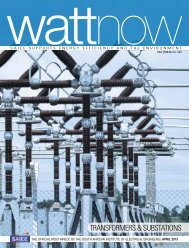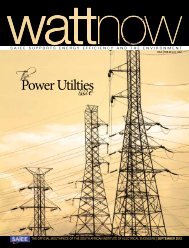Cut electricity consumption with automation - Watt Now Magazine
Cut electricity consumption with automation - Watt Now Magazine
Cut electricity consumption with automation - Watt Now Magazine
Create successful ePaper yourself
Turn your PDF publications into a flip-book with our unique Google optimized e-Paper software.
Shahidehpour says that the term smart grid applies to the<br />
optimisation of the distribution infrastructure which can be achieved<br />
by using a wide range of information technologies that analyse<br />
complex energy systems on a minute-by-minute basis and optimise<br />
the <strong>electricity</strong> usage in a cost-effective way.<br />
In explaining the concept Shahidehpour says that demand-response<br />
(DR) is the best example of how an effective smart grid operates.<br />
“People in South Africa, for instance, are asked to reduce power<br />
<strong>consumption</strong> at peak times and I’ve even seen announcements on<br />
television requesting viewers to switch-off unnecessary lights and<br />
appliances because power <strong>consumption</strong> was reaching critical levels.<br />
“What smart grids do is control <strong>consumption</strong> using different<br />
technologies to reduce power usage when the <strong>consumption</strong> is at a<br />
peak.”<br />
He says that demand-response mechanisms could substantially<br />
reduce the billions of rands invested in power generation by cutting<br />
the need for costly peak power infrastructure to keep the <strong>electricity</strong><br />
supply constant.<br />
“Consider that about ten percent of infrastructure costs are spent<br />
to meet peak demand that occurs less than one percent of the time<br />
so it’s evident that grid operators have a good reason to reduce the<br />
peaks,” he adds.<br />
Referring to statistics in the United States, Shahidehpour says<br />
that commercial and industrial buildings represent about 40 percent<br />
of the US energy use and homes account for about 30 percent. This<br />
means that demand-response technologies could provide a significant<br />
opportunity to conserve energy.<br />
Explaining how the smart grid works, Shahidehpour says that<br />
today’s electrical wall sockets are the power equivalent of a dumb<br />
terminal connected to a mainframe computer. Each access point – or<br />
wallsocket – can be identified in much the same way as a computer<br />
device has an address on the Internet.<br />
14

















